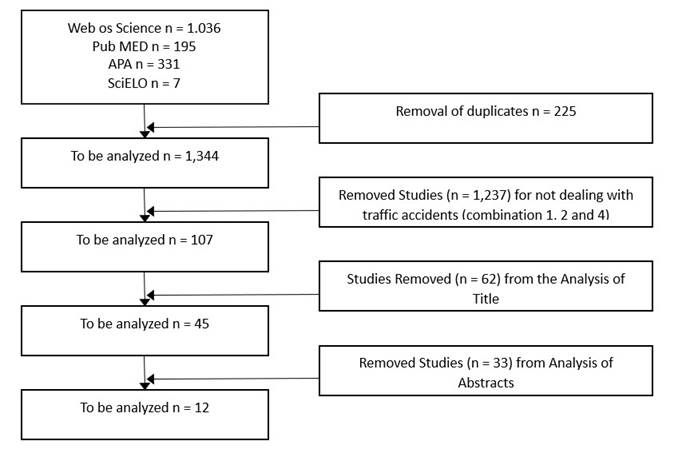Traffic accidents are a problem with serious consequences around the world (World Health Organization, 2018). The high rates of fatalities and serious injuries are increasing annually (Guest, Tran, Gopinath, Cameron, & Craig, 2016a). According to the World Health Organization (WHO) traffic crashes are responsible for the deaths of 1.2 million people and about 30 to 40 million are seriously worldwide injured each year (World Health Organization, 2018). These data replicate exponentially in the Brazilian territory where traffic violence is a cause for concern. Thus, federal agencies, such as the Ministry of Health and the Ministry of Regional Development, recognize the issue as a public health problem (Cavalcante, Morita, & Haddad, 2009; Costa & Araújo, 2019).
Due to this scenario, national and international research has been dedicated to highlighting the preventive aspects of traffic accidents (Chu, Wu, Atombo, Zhang, & Özkan, 2019; Moraes, Cunha, & de Andrade, 2019; Rosenbloom & Perlman, 2016; Sommer et al., 2008; Twisk, Bos, & Weijermars, 2017). Such investigations focus on the individual behaviors or personality traits that precede traffic accidents and that sometimes generate drastic consequences on the personal, family, professional, and social quality of life of those involved (Guest et al., 2016a; Rosenbloom & Perlman, 2016; Suriá, 2015).
Despite the social and scientific relevance of the topic, there is a notorious lack of research focusing on the experiences of positive adaptation and resilience in the post-accident phase. Moreover, the individualistic perspective of the investigations limits the ecological, systemic, and relational understanding of the resilience phenomenon (Daly, 1999). Therefore, it is justified the development of integrative literature review studies on the scientific scenario of research on resilience in victims and families of traffic accidents and their related support networks. It is important to understand how these investigations are developed, organized, and published over the last 10 years. Thus, it is expected that the results can subsidize public policies of care and support interventions for these populations.
Therefore, the present study aims to investigate the state of the art of research that deals with the experiences and processes of resilience in traffic accident victims with permanent sequelae and in their families searching to identify the role of support networks in the post-accident context. Thus, in addition to contributing to the design, implementation and execution of positive intervention programs for these populations, it will be possible to offer subsidies for a model of professional care practices focused on the empowerment and resilience of the victims and of their families.
The unpredictability of a traffic accident causes multiple situations of stress and suffering to the individual and to their families. This can trigger feelings of vulnerability, contextual changes, and inability to cope with the moment (Alves, 2017). Understanding that these situations bring a number of risk factors the phenomenon of resilience discussed (Masten, 2014; Rutter, 2012; Walsh, 2005a; Yunes, Pietro, Silveira, Juliano, & Garcia, 2015).
Resilience is a construct based on the Positive Psychology movement (Seligman & Csikszentmihalyi, 2000) and defined as dynamic processes that result from the interaction of risk situations and protective elements. There is consensus among scholars on the subject that resilience is also a system of development that enables individuals, families, and communities to reorganize themselves in a healthy way and re-signify situations of suffering and adversity (Masten, 2014; Pacico & Bastianello, 2014; Yunes, 2003, 2015).
Many studies in the field of health sciences understand resilience as a personality trait or even as a neuropsychological characteristic of the individual and, therefore, measurable (Bonanno, 2004). These usually unidimensional measures tend to assess stable conditions of the subject at a given moment and miss the contextual, relational, and dynamic processes that the phenomenon presents (Reppold, Mayer, Almeida, & Hutz, 2012). In contrast, other researchers on the subject develop studies focusing on processes, perceptions, analyses of meanings obtained from qualitative methodological procedures and reports of experiences and life stories (Masten, 2014; Rodrigo, 2010; Rutter, 2012; Walsh, 1996, 2005a, 2016; Yunes, 2003, 2015; Yunes & Szymanski, 2003). The results of these research highlight the family as an important element of the social support network for promoting resilience processes (Queiroz et al., 2016; Srinivas Goli, Siddiqui, & Gouda, 2018; Wu, 2011; Zanelato, 2008).
Among the investigators of resilience in families, the pioneer work of Froma Walsh presents a theoretical model already recognized for more than 20 years (Walsh, 1996). According to Walsh (2016), family resilience refers to the ability of family system not just to resist and recover from adversity but to become stronger and with more resources. The author states that more than coping or surviving family resilience involves the positive adaptation of the group with outcomes of personal, relational transformation and the growth built through experiences of learning. From this perspective the studies focused on resilience processes in families seek to identify the healthy and successful aspects of the family group as a unit, rather than pointing out its maladjustments and deficits (Walsh, 2005b, 2016; Yunes, Garcia, & Albuquerque, 2007). It is about highlighting aspects that make families not only to face situations of suffering or crisis, but to come out stronger from traumatic moments (Walsh, 1996, 2016; Yunes, 2015; Yunes, Mendes, & Albuquerque, 2005).
With regard to research with victims and families that experienced traffic accidents, results show that friendship bonds and social support in the community are key elements to promote resilience (Queiroz et al., 2016; Srinivas Goli et al., 2018; Wu, 2011; Zanelato, 2008). The study of Chouinard, Melançon, and Mandeville (2012) was with patients severely injured in a traffic accident and in the process of rehabilitation. These researchers identified that elements such as spirituality and the constant search for life meaning contribute to activate resilience processes by promoting feelings such as hope and well-being in the individual and the family.
According to Amparo, Galvão, Alves, Brasil & Koller (2008), resilience processes are closely linked to social support networks, which represent an important factor for the promotion of care, protection, and empowerment of the individual in the face of suffering. These processes, according to Walsh (2016) become more effective when there is support and protective networks.
Squassoni and Simões Matsukura (2014) state that the support network is characterized as a work that a group of people offer to people in vulnerable contexts. The supportive relationships can be in closer contexts, such as family, friends, neighbours, or are distant or unknown people. Moreover, Juliano and Yunes (2014) in verified that support networks play a key role in resilience processes and protect the development of the individual and communities.
A study conducted by Queiroz et al. (2016), showed positive evidence that support networks contribute to the promotion of resilience processes in victims and families who have experienced traffic accidents with severe physical and psychological sequelae. Cavalcante et al. (2009) point to the importance of promoting and implementing strategies aimed at minimizing the effects related to the trauma of the accident. Thus, there is a need to invest in training caretakers of social services that receive victims of traffic accidents as part of the social support network.
International studies such as Tavernier et al. (2017) have also shown that the protective social support network is widely recognized as a buffer and promoter of resilience for victims of traffic accidents. This points to the importance of enabling the integration of family members in the caretaking processes. The relevance of bonds and significant relationships should also be emphasized as they make the victimized person to feel cared and supported. Researchers from Norway, Italy, Turkey, and Greece conducted a literature review in which the studies demonstrated the need to publish more research that demonstrate and map the networks of care for traffic accident victims in different world contexts. The results show that the lack of integration between the systems of care and social support networks impacts negatively and significantly in the quality of life, future expectations, and rehabilitation of the injured victims (Üzümcüoğlu et al., 2016).
This present research sought to identify the scenario of publications that highlight the expressions and processes of resilience both in victims, severely injured and in their families as well as the role of support networks in the context of the consequences of the traffic accidents. It is expected that the results of this study can provoke theoretical and methodological reflections upon resilience as a human, community, and political phenomenon. It is aimed offer tools to build scientific knowledge that could indicate new paths and strategies for future research, interventions and public policies.
Method
The present study was developed from July to December 2019 and was methodologically based on the guidelines for integrative literature review according to Whittemore and Knafl (2005) which consists of 5 stages.
Stage 1: Identification of the problem/research question
The question to be addressed in this study is to analyse the state of the art of published research related to the association of these themes: processes of individual and family resilience and the support networks of traffic accident victims in the post-accident context.
Stage 2: Literature search
The data collection for this study was made from secondary sources of a bibliographical survey. The databases used were: PsycInfo (APA), PubMed, Web of Science and Scientific Electronic Library Online (SciELO).
According to Rocha, Ferreira, and Vieira (2018), the most effective way to find synonyms for the key words is to use the thesaurus base. In this study, the resource employed was the use of the terminology bank and controlled vocabulary to identify the search terms, including the Thesaurus of Psychological Terms for PsycInfo, Medical Subject Headlines Terms from PubMed, and health descriptors from the Virtual Health Library. As shown in Table 1, the following descriptors and their combinations in Portuguese and English were used: resilience, family resilience, traffic accident, and support network.
Table 1: The four elements of Portuguese and English language search and thesaurus identified in the analysed knowledge bases
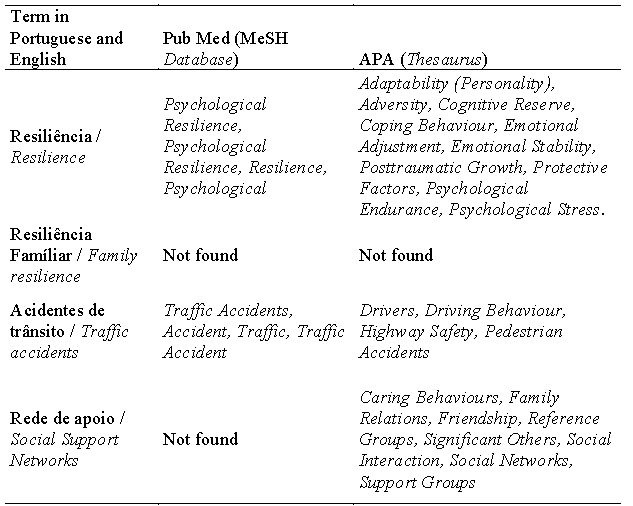
Note: No thesaurus was identified in Web of Science and SciELO
After identifying the thesaurus in the analysed databases and considering the most used terms in the key words field of the publications related to the research objective, a list of synonyms emerged. A basic search logic was developed for advanced searches in which the elements of the study and their synonyms were connected by Boolean operators, as shown in Figure 1.
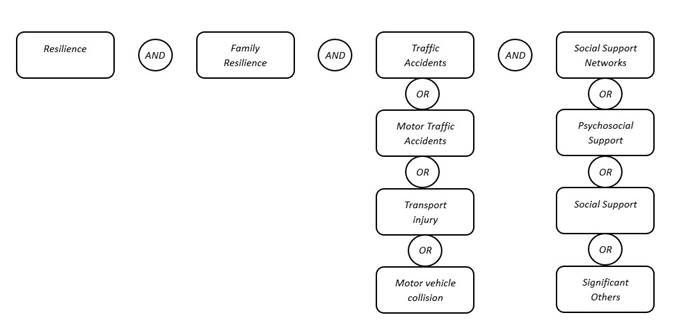
Figure 1: Search elements (connected by the AND operator) and, where applicable, their synonyms / thesaurus (connected by the OR operator)
Based on the described search logic, different syntaxes were elaborated to perform advanced searches in each knowledge base according to the relative particularities of each one, as seen in Table 2.
Table 2: Search elements, their synonyms connected by Boolean operators and the syntaxes of the knowledge bases
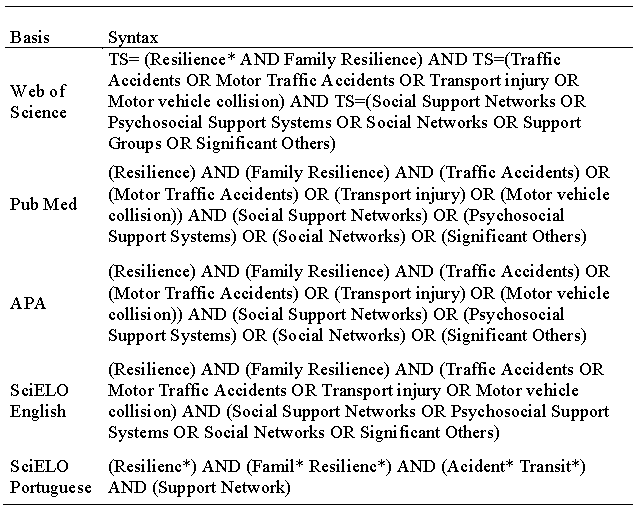
When the search was realized with the four constructs of the study and their synonyms in the selected databases, the result brought up a small number of publications, according to the first row of Table 3, which reinforces the relevance of conducting research that works simultaneously with all the elements (1) resilience, (2) traffic accident, (3) family resilience and (4) support network. One way to further investigate this issue was to proceed a new research combining the four constructs in groups of three by three, that is, with four combinations (1, 2, 3); (1, 2, 4); (2, 3, 4,) and (1, 3, 4). Additionally, research was conducted with the combination of the two main constructs, (1) Resilience and (3) Traffic Accident. As expected, the surveys conducted with these combinations generated a greater number of results when compared to the survey conducted with all four elements simultaneously, as shown in Table 3.
Table 3: Number of studies resulting from the searches in the knowledge bases with different combinations of the search elements. Being 1: Resilience, 2: Family Resilience, 3: Traffic Accident and 4: Support Network.
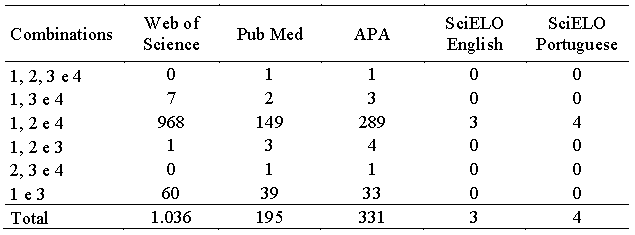
The inclusion criteria defined for the selection of articles were: publications carried out in the last ten years, with themes related to victims (seriously injured) of traffic accidents in a post-accident context, which identified processes of individual and/or family resilience and the role of support networks.
For the selection of the studies, four steps were performed: (i) removal of duplicate material; (ii) exclusion of studies that did not address traffic accidents; (iii) publication title analysis; (iv) abstract analysis.
After the elimination of duplicate studies, the first exclusion criterion applied was the removal of studies that did not deal with traffic accidents. Table 3 shows that the combination with the largest number of publications (1, 2, 4) and associates resilience, family resilience, and support network, without, however, including the element and context of the research that is: Traffic Accident. As this is one of the main elements of the study, this combination was excluded in the selection criteria.
Next, in the analysis of titles, studies that already indicated in the title that they did not investigate victims of traffic accidents, individual and/or family resilience, and support networks in a post-accident context were also excluded. Finally, the analysis of the abstracts was performed with the participation of three judges, who in consensus, excluded the studies that did not focus on individual and/or family (psychological) resilience and support networks for traffic crash victims with serious injuries. Studies about prevention of traffic accidents were also excluded. The quantification of these exclusion steps can be seen in Figure 2.
Stage 3: Data collection
The extraction and analysis of the selected studies was based on the protocol of Souza, da Silva and De Carvalho (2010), which was adapted for this research. The analysis and synthesis of the extracted data were performed descriptively, which made it possible to observe, describe and classify the information in order to gather the knowledge produced in relation to the theme explored in the review. The use of this tool also made possible to identify and categorize characteristics of the studies, such as type of publication, year, authors, countries of origin, methodological design, sample, and other relevant information, as shown in Table 4.
Table 4: Information extracted with application of the Data Collection Instrument (Souza et al., 2010) from the selected studies
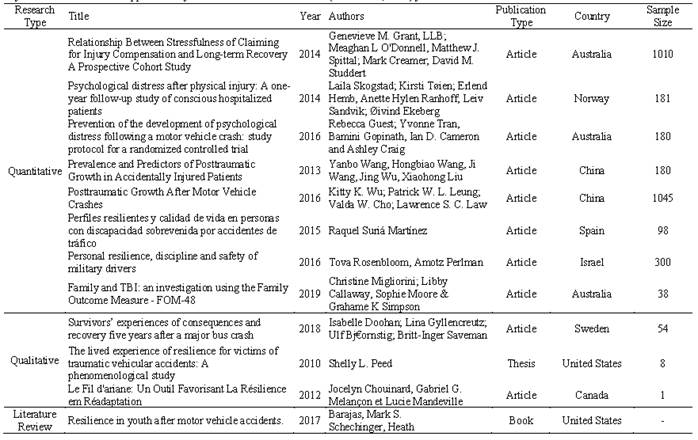
Results
Stage 4: Data Analysis
In this review 12 studies published in the last 10 years were selected, of which 84% (10) were articles, 8% (1) a book, and 8% (1) a thesis. Of the 12 selected studies, 58% (7 studies) were indexed in the APA database, 25% (3) in PubMed, and 17% (2) in the Web of Science. It is worth noting that the same article could be in more than one database at the same time. In relation to this analysis, out of the 7 studies identified in APA, 1 was also present in PubMED, 1 in Web of Science, and another was present in all three bases at the same time (Wu et al., 2016).
The highest concentration of years of publication in the material analysed was between 2014 and 2016, or 50% of the database. Regarding language, 83% (10 studies) were publications written in English, one in Spanish and one in French. The selected studies were distributed in 8 countries, with Australia having the highest concentration of publications or 3 out of 12 studies. United States and China presented 2 publications each. The other 5 studies were distributed among Norway, Canada, Sweden, Israel, and Spain.
Concerning the host institution of the study, 75% (9) were conducted in universities, the remaining 3 studies were from Multicenter Research. Skogstad et al. (2014) was the result of a joint research between a hospital and two universities, Wu et al. (2016) was developed by 2 universities and 2 medical centres. Finally, the study of Migliorini et al. (2019) was conducted by two universities and a medical institute.
Regarding the type of publication, it was found that 50% (6) of the studies were from the medical field, 42% (5) from psychology and 8% (1) from nursing. Regarding the methodological characteristics of the analysed studies, 67% (8) were research with a quantitative design, 25% (3) with a qualitative design, and 8% (1) literature review.
As for the sample size of the publications, disregarding the literature review study, there were samples with a single individual (Chouinard et al., 2012) to samples exceeding one thousand participants (Grant et al., 2014; Wu et al., 2016). The average sample size of the 11 studies is M= 281 participants with a SD = 380. As expected, the three qualitative studies (Chouinard et al., 2012; Doohan et al., 2018; Peed, 2010) are the ones with the smallest amounts of participants, being one study with a single sample (Chouinard et al., 2012), another with 8 participants (Peed, 2010) and, finally one, study with 54 participants (Doohan et al., 2018).
Regarding the instruments, the quantitative studies showed the use of scales, tests, questionnaires, and in the qualitative ones the use of personal and telephone interviews, focus groups, and life stories were chosen as procedures to collect data. One scale in particular was identified in three consecutive studies (Peed, 2010; Skogstad et al., 2014; Wu et al., 2016): the Connor-Davidson Resilience Scale - CD-RISC (Connor & Davidson, 2003).
It should also be pointed that the 12 selected studies were prepared by different authors. Regional similarities were found, with Australia having the largest number of publications (3 of 12). The Australian studies (Grant et al., 2014; Guest et al., 2016a; Migliorini et al., 2019) were published in different periods, in different journals, and the only similar characteristic they share is that they are quantitative studies.
Discussion
Stage 5: Presentation of the integrative review
The objective of this study was to map research focused on the association of these topics: processes of individual/family resilience and the role of support networks in cases of traffic accident victims only in the post-accident context. It was aimed to present where, when and by whom these studies were conducted along with an analyses on the methodological design of the publications.
The publications were selected by the inclusion criteria showed by the lack of research on resilience in the context of the period after the victim suffer the traffic accident. Studies on this period are represented by a gap that was emphasized as one of the assumptions of this review. This hypothesis can be evidenced in Table 3, which showed the low number of studies with the association of topics related to resilience and traffic accidents.
The definitions of resilience as a mechanism of overcoming and rebuilding life with new meanings in situations of suffering and adversity (Masten, 2014; Pacico & Bastianello, 2014; Yunes, 2003) are present in most of the selected studies, both qualitative (Chouinard et al, 2012; Doohan et al., 2018; Peed, 2010) and quantitative (Grant et al., 2014; Guest, Tran, Gopinath, Cameron, & Craig, 2016b; Migliorini et al., 2019; Rosenbloom & Perlman, 2016; Skogstad et al., 2014; Suriá, 2015; Wang, 2013; Wu et al., 2016).
With regard to the focus and methodological aspects of the investigations about the phenomenon of resilience in the context of traffic accidents, the results showed that most studies were quantitative with focus on individual aspects. This is in agreement with the findings of Reppold et al. (2012) who found that many studies in the area of health understand resilience as an individual characteristic or personality trait, and therefore is measurable.
Regarding family resilience, the selected publications showed that qualitative studies brought up in more depth the importance of family support. However, both qualitative studies (Chouinard et al., 2012; Doohan et al., 2018; Peed, 2010) and quantitative studies (Migliorini et al., 2019; Suriá, 2015; Wang, 2013; Wu et al., 2016) demonstrated that regardless of the instruments used social support and family support are important aspects in the recovery of the victim and others involved. Such results corroborate studies by Walsh (1996, 2016); Yunes (2015); Yunes et al. (2005) in which it was verified that support networks, care, protection and family support contribute to a positive adaptation of those involved in the face of the new reality.
Importantly, the only study resulting from the simultaneous search for the four research topics was the work of Wang (2013) in China. This researcher demonstrated results of individual and family resilience in patients of accidents who are in the post-trauma situation. According to Wang (2013), positive outcomes are closely associated with the quality of social interaction with supportive family members, including the presence of a spouse. Family cohesion and resilience are also highlighted in the work of Migliorini et al. (2019), who although not working with a focus on the four aspects mentioned above, demonstrates that healthy developmental outcomes of the injured person relates to the positive adjustments in the belief system and reorganization of family dynamics.
Regarding the support network, the studies showed that social care and support network contributes to the recovery of the victim and of their families. Their lives in the post-accident context need more attention. These results were more evident in the study of Barajas and Schechinger (2018); Migliorini et al. (2019) who identified that the more available the support and care network is, the greater are the chances of promoting the recovery processes, reinvention, new meanings and changes for better in the quality of life of the victim and families. In this sense, it was possible to verify that these results corroborated those of Amparo et al. (2008), who found that resilience processes are closely linked to the presence and quality of social support networks. According to Walsh (2016), such processes are more active, effective, and enduring when support, care, and protection networks work together and in line with the population in need.
Conclusion
Traffic accidents that leave people seriously injured represent a worldwide problem. This review demonstrates the low number of studies and publications that focus simultaneously on the healthy aspects of individual and families. Therefore, more investigations on resilience and the protective role of support networks is necessary to fill up this gap. In addition, it was detected that research with qualitative designs is represented by a reduced number of publications. This may hinder the understanding of the complexities of the resilience phenomenon as systemic, relational, and ecological. Moreover, the absence of publications searched with the descriptors used in the literature research in the basis of SciELO indicated that these studies have not been published in Latin America.
It is important to emphasize that future research on the discussed topics of this review, should investigate aspects of health and positive adaptation processes of individuals and families. Moreover, the association and identification of important public services that give support and protection for these populations is another key element. To offer a network system with relational and professional quality must be top priority of a public policy in the field of traffic accidents.
It is expected that these results would call for theoretical and methodological reflections upon resilience as a human, community, and political phenomenon. In conclusion, we aim to have contributed with scientific knowledge that indicates new paths and strategies for future research and interventions that ensure the well-being of people who suffer from a traffic accident and are left with lifelong severe injuries.











 text in
text in 


